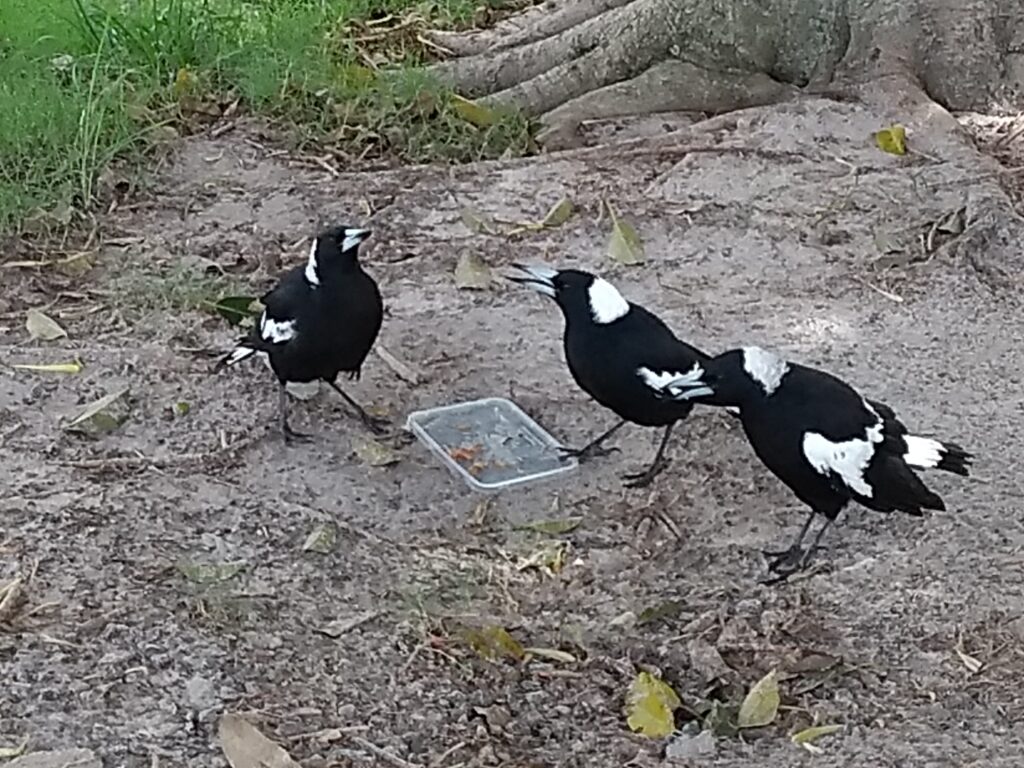
A group of Australian magpies have taught the scientists who were studying them an unexpected lesson.
The scientists were trying to develop a way of tracking where the birds go. They needed a “GPS” tracking system that was light enough for a small bird to wear.
GPS (Global Positioning System) devices are used track an animal’s movements so scientists can learn more about where they live and how they behave. This helps scientists understand how animals might be affected by changes to their environment, and how to protect them.
The research team was led by Dominique Potvin, an animal ecologist at the University of the Sunshine Coast in Australia. They developed a GPS harness that weighed only three grams—about the same as three raisins.
Magnet harness
The harness also had a special feature. It contained a tiny fastener, about one millimetre long, that would open automatically when the bird was near a magnet, causing the harness to fall off. The researchers planned to set up magnets at feeding stations, so when a bird landed on the station, the magnet would release the harness. After the bird flew away, the researchers could get the tracking device and look at the information stored in it.
They chose the Australian magpie for their first trial. Magpies are about 36 to 44 centimetres long and weigh about 300 grams—about the same size as a pigeon.
The researchers set up feeding stations in an area that was home to a group of magpies. After six weeks, they set soft net traps on the feeding stations and caught five magpies for their trial.
The birds were fitted with GPS harnesses, and bands were attached to their legs so they could be identified. Then they were released.
Almost immediately, the researchers saw one bird pecking at its harness. Two birds that had not been trapped came up to the first bird and pecked at the harness as well. Within half an hour, one of the “helper” birds found the magnetic clasp and snipped it with its beak. The harness fell off.
Helping one another
Then the researchers saw a different magpie help remove another one’s harness. Altogether, they saw four birds being helped out of their harnesses. By the fourth day, all of the harnesses were off.
The researchers were disappointed that their harnesses didn’t work. But they realized they had learned two important things about the magpies.
One was that the magpies are able to solve difficult problems, like figuring out how to remove the harnesses.
The second lesson was that several other birds helped a bird that they thought was in trouble.
Many birds that live in groups work together at tasks like hunting or raising their babies, for the good of the whole group. But these birds were demonstrating selfless behaviour. One bird helped another even though it didn’t gain any personal benefit from the good deed.
The researchers said that people who are designing new tracking systems for birds should remember that some birds work together to solve problems.
Think & Discuss
- The article mentions a “GPS tracking system.” Why do the researchers want to track the birds? What in the article tells you that?
2. The article says that magpies solved a “difficult” problem. Is opening a harness really that difficult? Why or why not?
3. What did the researchers hope to learn? What did they actually learn? Which do you think was more valuable?
4. Now that the researchers know this about magpies, what do you think they will do with that information?
5. The article mentions that the harnesses had to be very light. How do you think the research could have been affected if the harnesses were too heavy?
6. Do you think the researchers will invent a new type of fastener for the harnesses? What do you think it should look like?
7. This diagram, by USC Australia, illustrates the way the research was designed to go. Write a caption for each illustration that describes each frame.

Links
CBC’s As It Happens radio show interviewed the lead researcher: https://www.cbc.ca/radio/asithappens/as-it-happens-the-tuesday-edition-1.6368907/tenacious-australian-magpies-help-each-other-remove-scientists-tracking-devices-1.6368911
Smithsonian article: https://www.smithsonianmag.com/smart-news/sneaky-magpies-outwit-scientists-by-removing-tracking-devices-180979634/
Wicked Wildlife video (4:24) showing an Australia Magpie and talking about its features: https://www.youtube.com/watch?v=fHcmmL6Rcto
New York Times video talking about how crows are very smart and have learned to do some advanced tasks: https://www.youtube.com/watch?v=s2IBayVsbz8
A funny video with a man on a bike who shows you different ways to avoid swooping magpies: https://www.youtube.com/watch?v=u23B-lHNn_0
From USC Australia, this brief (38-second) video shows the magpies removing the harnesses:







